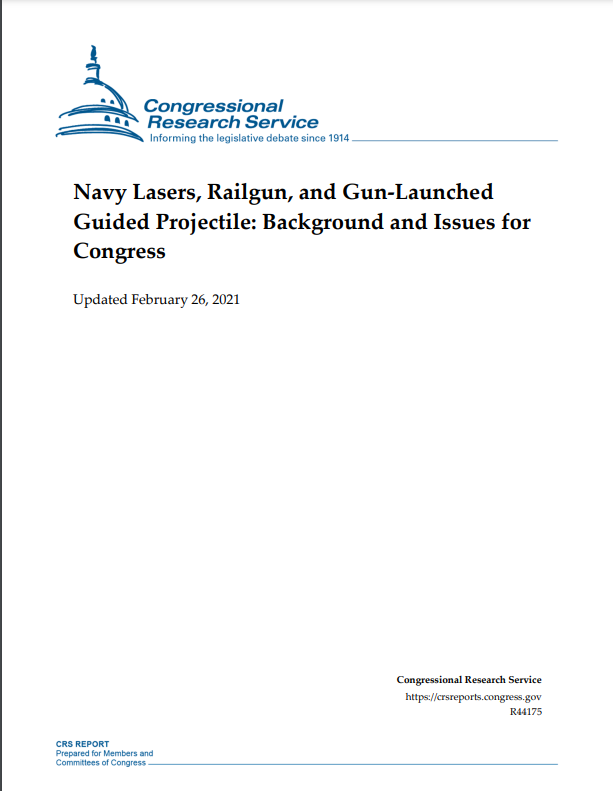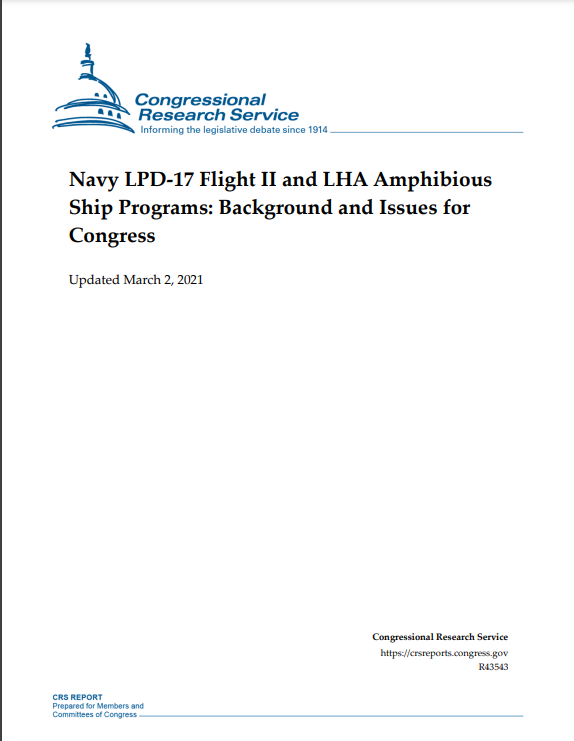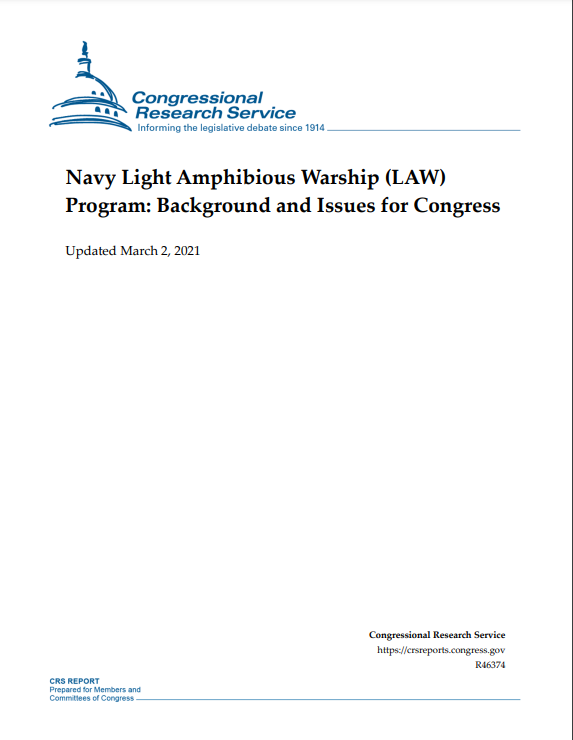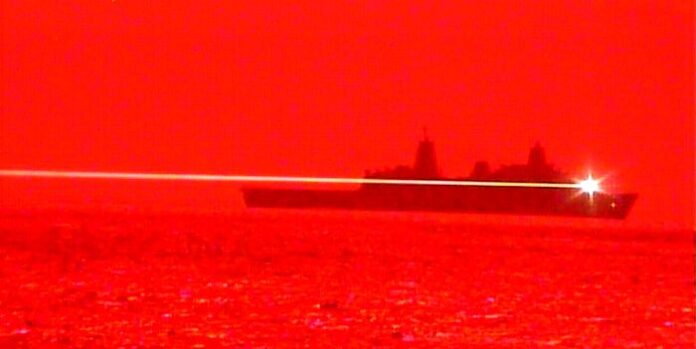3 New Congressional Research Service Reports covering naval issues have been published. The reports are:
Summary of the Reports:
1. Navy Lasers, Railgun, and Gun-Launched Guided Projectile: Background and Issues for Congress (Congressional Research Service Report)
Three new ship-based weapons being developed by the Navy—solid state lasers (SSLs), the electromagnetic railgun (EMRG), and the gun-launched guided projectile (GLGP), also known as the hypervelocity projectile (HVP)—could substantially improve the ability of Navy surface ships to defend themselves against surface craft, unmanned aerial vehicles (UAVs), and eventually antiship cruise missiles (ASCMs).
The Navy has been developing SSLs for several years, and in 2014 installed on a Navy ship its first prototype SSL capable of countering surface craft and UAVs. The Navy since then has been developing and installing additional SSL prototypes with improved capability for countering surface craft and UAVs. Higher-power SSLs being developed by the Navy are to have a capability for countering ASCMs. Current Navy efforts to develop SSLs include;
- the Solid State Laser Technology Maturation (SSL-TM) effort;
- the Optical Dazzling Interdictor, Navy (ODIN);
- the Surface Navy Laser Weapon System (SNLWS) Increment 1, also known as the high-energy laser with integrated optical dazzler and surveillance (HELIOS);
- the High Energy Laser Counter-ASCM Program (HELCAP).

The first three efforts above are included in what the Navy calls the Navy Laser Family of Systems (NFLoS) effort. NFLOS and HELCAP, along with technologies developed by other parts of DOD, are to support the development of future, more capable shipboard lasers.
The Navy has been developing EMRG for several years. It was originally conceived as a naval surface fire support (NSFS) weapon for supporting Marines and other friendly forces ashore.
Subsequently, it was determined that EMRG could also be used for air and missile defense, which strengthened Navy interest in EMRG development. The Navy is continuing development work on EMRG, but it is unclear when production-model EMRGs will be installed on Navy ships. The Navy’s FY2021 budget submission requested $9.5 million in FY2021 for continued development
of EMRG, but did not appear to program any additional development funding for EMRG in FY2022-FY2025.
As the Navy was developing EMRG, it realized that the guided projectile being developed for EMRG could also be fired from powder guns, including 5-inch guns on Navy cruisers and destroyers and 155 mm artillery guns operated by the Army and Marine Corps.
The concept of firing the projectile from powder guns is referred to as GLGP and HVP. One potential advantage of HVP/GLGP is that, once developed, it can be rapidly deployed on Navy cruisers and destroyers and in Army and Marine Corps artillery units, because the powder guns in question already exist.
In addition to the question of whether to approve, reject, or modify the Navy’s annual funding requests for SSLs, EMRG, and HVP/GLGP, issues for Congress include the following:
- whether the Navy is moving too quickly, too slowly, or at about the right speed in
its efforts to develop these weapons; - the Navy’s plans for transitioning these weapons from development to procurement and fielding of production models aboard Navy ships; and
- whether Navy the Navy’s shipbuilding plans include ships with appropriate amounts of space, weight, electrical power, and cooling capacity to accommodate these weapons.
2. Navy LPD-17 Flight II and LHA Amphibious Ship Programs: Background and Issues for Congress (Congressional Research Service Report)
This report discusses two types of amphibious ships being procured for the Navy: LPD-17 Flight II class amphibious ships and LHA-type amphibious assault ships. Both types are built by Huntington Ingalls Industries/Ingalls Shipbuilding (HII/Ingalls) of Pascagoula, MS. The first LPD-17 Flight II class ship, LPD-30, was procured in FY2018. LHA-type amphibious assault
ships are procured once every few years.

The Navy’s FY2021 budget submission presented the second LPD-17 Flight II class amphibious ship, LPD-31, as a ship requested for procurement in FY2021, and the next amphibious assault ship, LHA-9, as a ship projected for procurement in FY2023. Consistent with congressional action on the Navy’s FY2020 budget, this CRS report treats LPD-31 and LHA-9 as ships that
Congress procured (i.e., authorized and provided procurement—not advance procurement— funding for) in FY2020. The Department of Defense’s (DOD’s) decision to present LPD-31 and LHA-9 in its FY2021 budget submission as ships requested for procurement in FY2021 and FY2023, respectively, even though Congress procured both ships in FY2020, posed an institutional issue for Congress regarding the preservation and use of Congress’s power of the purse under Article 1 of the Constitution, and for maintaining Congress as a coequal branch of government relative to the executive branch. Section 126 of the FY2021 National Defense Authorization Act (NDAA) (H.R. 6395/P.L. 116-283 of January 1, 2021) states:
SEC. 126. TREATMENT IN FUTURE BUDGETS OF THE PRESIDENT OF SYSTEMS ADDED BY CONGRESS.
In the event the procurement quantity for a system authorized by Congress in a National Defense Authorization Act for a fiscal year, and for which funds for such procurement quantity are appropriated by Congress in the Shipbuilding and Conversion, Navy account
for such fiscal year, exceeds the procurement quantity specified in the budget of the President, as submitted to Congress under section 1105 of title 31, United States Code, for such fiscal year, such excess procurement quantity shall not be specified as a new
procurement quantity in any budget of the President, as so submitted, for any fiscal year after such fiscal year.
Section 124 of P.L. 116-283 provides authority for the Navy to use a block buy contract for the procurement of three LPD-17 class ships and one LHA-type amphibious assault ship. Such a contract would be the first block buy contract to cover the procurement of ships from two separate ship classes.
A key issue for Congress concerns the Navy’s force-level goals for amphibious ships and the effect these goals could have on future procurement of LPD-17 Flight II and LHA-type ships. The Navy’s current force-level goal, released in December 2016, calls for achieving and maintaining a 355-ship fleet that includes 38 amphibious ships—12 LHA/LHD-type amphibious assault ships,
13 LPD-17 Flight I class ships, and 13 LPD-17 Flight II class ships (12+13+13). The Navy and DOD since 2019 have been working to develop a new force-level goal to replace the Navy’s current 355-ship force-level goal. On December 9, 2020, the outgoing Trump Administration released a document that presents an envisioned Navy force-level goal for achieving by 2045 a Navy with 61 to 67 amphibious ships, including 9 to 10 LHA/LHD-type ships and a combined total of 52 to 57 LPD-type ships and Light Amphibious Warships (LAWs). (LAWs are a planned new kind of amphibious ship that are covered in another CRS report.) The December 9, 2020, the document also calls for a future Navy with 0 to 6 light aircraft carriers (CVLs). The design for such carriers, if any are procured, might be based on the LHA design. In establishing its force level goals and shipbuilding plans for the Navy, the Biden Administration can choose to adopt, revise, or set aside the December 9, 2020, document.
3. Navy Light Amphibious Warship (LAW) Program: Background and Issues for Congress (Congressional Research Service Report)
The Navy’s new Light Amphibious Warship (LAW) program envisions procuring a class of 28 to 30 new amphibious ships to support the Marine Corps, particularly in implementing a new Marine Corps operational concept called Expeditionary Advanced Base operations (EABO). The Navy envisions the first LAW being procured in FY2022.
The Navy’s proposed FY2021 budget requested $30 million in research and development funding for initial industry studies and concept design work on the ship. As part of its action on the Navy’s proposed FY2021 budget, Congress provided $24.0 million in research and development funding for the program.

The EABO concept was developed with an eye toward potential conflict scenarios with China in the Western Pacific. Under the concept, the Marine Corps envisions, among other things, having reinforced-platoon-sized Marine Corps units maneuver around the theater, moving from island to island, to fire anti-ship cruise missiles (ASCMs) and perform other missions so as to contribute, alongside Navy and other U.S. military forces, to U.S. operations to counter and deny sea control to Chinese forces. The LAW ships would be instrumental to these operations, with LAWs embarking, transporting, landing, and subsequently reembarking these small Marine Corps units.
As conceived by the Navy and Marine Corps, LAWs would be much smaller and individually much less expensive to procure and operate than the Navy’s current amphibious ships. The Navy wants LAWs to be 200 to 400 feet in length, and to have a unit procurement cost of $100 million to $150 million.
The LAW as outlined by the Navy is small enough that it could be built by any of several U.S. shipyards. The Navy states that in response to an initial request for information (RFI) about the LAW, it received responses from 13 firms, including nine shipyards. The Navy’s baseline preference is to have a single shipyard build all 28 to 30 ships, but the Navy is open to having them built in multiple yards to the same design if doing so could permit the program to be implemented more quickly and/or less expensively.
The LAW program poses a number of potential oversight matters for Congress, including the merits of the EABO concept, how LAWs would fit into the Navy’s future fleet architecture, the Navy’s preliminary unit procurement cost target for the ship, and the industrial-base implications of the program.
The issue for Congress is whether to approve, reject, or modify the Navy’s annual funding requests and envisioned acquisition strategy for the program. Congress’s decisions regarding the program could affect Navy and Marine Corps capabilities and funding requirements and the U.S. shipbuilding industrial base.



